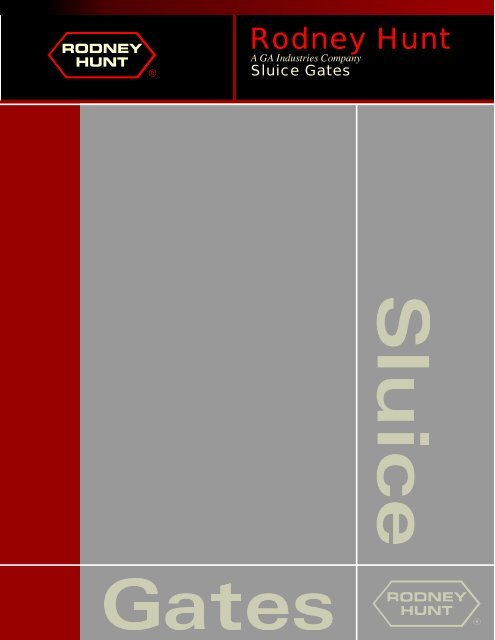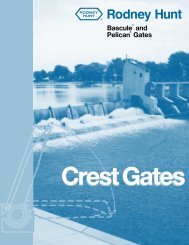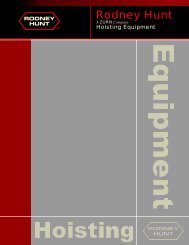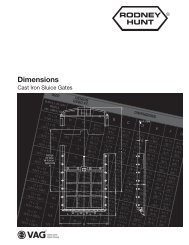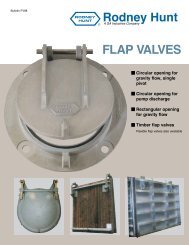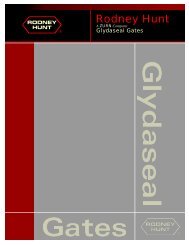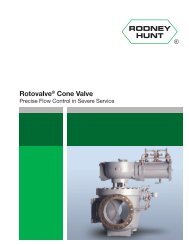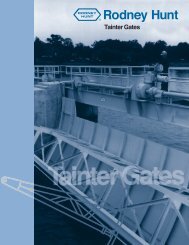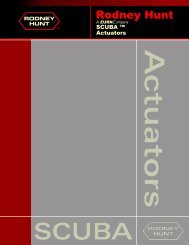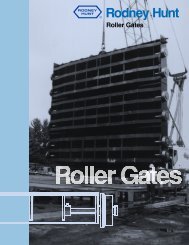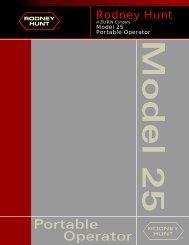Rodney Hunt Company
Rodney Hunt Company
Rodney Hunt Company
Create successful ePaper yourself
Turn your PDF publications into a flip-book with our unique Google optimized e-Paper software.
<strong>Rodney</strong> <strong>Hunt</strong><br />
A GA Industries <strong>Company</strong><br />
Sluice Gates
PIPE COVER<br />
FLOORSTAND<br />
OPERATING STEM<br />
STEM COUPLING<br />
STEM GUIDE<br />
GATE GUIDE<br />
TOP WEDGE<br />
SIDE WEDGE<br />
THRUST NUT<br />
DISC<br />
BOTTOM WEDGE<br />
ANCHOR BOLT<br />
WALL THIMBLE<br />
FRAME<br />
OPENING<br />
INVERT
The Typical<br />
Sluice Gate Installation<br />
The diagrams at left illustrate a typical sluice gate installation,<br />
showing a sluice gate with a wall thimble and crank operated<br />
floorstand. The more common component variations include<br />
handwheel actuators, benchstands, electric motor driven<br />
floorstands, hydraulic cylinders, self-contained gates and HY-Q<br />
flushbottom closure sluice gates. Other component arrangements<br />
are illustrated and described on pages 16 through 18.<br />
SLUICE GATE ASSEMBLY<br />
In its simplest form, a sluice gate assembly consists of a frame,<br />
guides and a disc or sliding member. The gate is normally<br />
constructed of cast iron with bronze seats. Bronze wedges hold<br />
the disc tightly to the frame in the closed position.<br />
WALL THIMBLE<br />
Use of a wall thimble is the recommended method of mounting the<br />
gate because it provides a rigid, machined mounting surface.<br />
Sluice gates can also be mounted on flanged pipe or directly to<br />
concrete walls with anchor bolts.<br />
CRANK OPERATED FLOORSTAND<br />
The crank operated floorstand has a geared head with roller<br />
bearings to support the opening and closing thrust loads. The<br />
head is enclosed and mounted on a pedestal secured to a<br />
concrete floor or structural support. Although the crank operated<br />
floorstand is the most common method of controlling a gate,<br />
handwheel actuators, motor driven actuators and hydraulic<br />
cylinders can also be used.<br />
OPERATING STEM<br />
The operating stem is a round shaft of bronze or stainless steel<br />
threaded on its upper portion to engage the floorstand lift nut.<br />
Sections of stem are joined together with cast bronze threaded<br />
and keyed couplings. When the length of an operating stem<br />
requires intermediate support an adjustable bronze bushed stem<br />
guide is furnished.<br />
A typical sluice gate installation demonstrates how the various components of a sluice<br />
gate assembly are put together.
NUT<br />
POCKET<br />
GUIDE<br />
UNIVERSAL FRAME<br />
TOP<br />
WEDGE<br />
SEAT<br />
FACING<br />
DISC<br />
SIDE<br />
WEDGE<br />
GUIDE
The Integral Frame Sluice Gate<br />
For Openings over 60” and Smaller<br />
NUT<br />
POCKET<br />
SIDE<br />
WEDGE<br />
KEYED<br />
WEDGE PAD<br />
WEDGE PAD<br />
BOLT<br />
TOP<br />
WEDGE<br />
ONE-PIECE<br />
GUIDE AND FRAME<br />
DISC<br />
SEAT<br />
FACING<br />
WEDGE PAD<br />
KEYED TO GUIDE<br />
KEYED<br />
WEDGE PAD<br />
WEDGE PAD<br />
BOLT
A<br />
The Wedge System<br />
Adjustable wedges of high tensile strength cast bronze are furnished on<br />
all <strong>Rodney</strong> <strong>Hunt</strong> sluice gates. The number and location of wedges used<br />
on any gate depends on gate size and the amount and direction of water<br />
pressure acting on the sluice gate.<br />
A gate subject to a seating head (a pressure which forces the disc and<br />
frame seats together) needs only side wedges to assure proper closure.<br />
Unseating heads, on the other hand, force the disc and frame seats apart,<br />
making additional wedges on top and bottom necessary.<br />
There are exceptions. The HY-Q gate for unseating heads needs only top<br />
and side wedges because it makes use of a resilient seal rather than<br />
bronze seats at the invert. Gates in widths 24" and under, subject to<br />
unseating heads, are usually supplied only with side wedges because of<br />
the support inherent in the short span of the disc.<br />
F<br />
B<br />
SIDE WEDGES<br />
Side wedges are keyed directly to the sluice gate disc to prevent rotation.<br />
Because the wedge and its contact surfaces are machined to match the<br />
exact angle of the bronze wedge seat, misalignment of the wedge is not<br />
possible, even through faulty field adjustment. After the wedge has been<br />
properly set using the adjusting bolt, a lock nut and hold-down stud are<br />
used as a double-lock feature to insure permanent setting. The accuracy<br />
of this wedge system results in low unit pressures uniformly distributed<br />
over bearing surfaces.<br />
TOP AND BOTTOM WEDGES<br />
Both top and bottom wedges make use of a bronze wedge hook and<br />
wedge loop or seat. Top and bottom wedge seats are bolted directly to the<br />
cast iron frame and keyed so that they will not move under force. The<br />
wedge hooks are provided with an adjusting bolt with a lock nut to maintain<br />
the proper setting.<br />
SIDE WEDGES TOP WEDGE BOTTOM WEDGE<br />
G<br />
D<br />
C<br />
E<br />
E<br />
G<br />
B<br />
A<br />
D<br />
F<br />
C<br />
E F<br />
LEGEND: A. BRONZE B. BRONZE C. BRONZE ADJUSTING SCREW D. HOLD DOWN E. BRONZE F. GATE G. GATE<br />
WEDGE WEDGE SEAT WITH LOCK NUT BOLT SEAT FACING DISC FRAME<br />
G<br />
B<br />
D<br />
A<br />
C
The Self-Contained Sluice Gate<br />
The selfcontained gate differs from other gates in that it absorbs the<br />
operating load created during opening and closing. This is<br />
accomplished through the use of a yoke, a supporting member<br />
mounted on the top of the extended guides. The thrust required to<br />
operate the gate is transmitted by the yoke and guides directly to the<br />
gate. In the conventional gate installation the load is absorbed by the<br />
floor or structure above the gate.<br />
A self-contained gate has the same general features as a conventional gate.<br />
Its cast iron frame, disc and guides are identical except that the guides are<br />
extended to provide clearance for the sliding member in the open position. A<br />
cast iron or structural steel yoke is mounted on machined pads at the top of<br />
the guides. Opening thrusts are transferred through the yoke and guides to<br />
the gate. This arrangement eliminates the transmission of operating loads to<br />
the floor above.<br />
All <strong>Rodney</strong> <strong>Hunt</strong> sluice gates are available as self-contained gates<br />
with yokes and with rising or non-rising stems. The self-contained<br />
gate is useful where space above the gate installation, or the<br />
absence of structural supports, limits the use of a separate operating<br />
floorstand or benchstand.<br />
Self-contained gates can be furnished with non-rising stems where there is<br />
inadequate clearance above the gate for a rising stem. Because the nonrising<br />
stem may be in the medium, it cannot be cleaned and lubricated and<br />
excessive wear of the thrust nut may result. For that reason, non-rising<br />
stems should be used only when there is no alternative.
The HY-Q® Sluice Gate<br />
The flushbottom closure of the HY-Q gate eliminates the need for<br />
vertical walls or pockets on the invert surface which might otherwise<br />
impede flow. Its distinguishing design feature is a heavy resilient strip<br />
attached to the bottom of the gate disc which makes an extremely<br />
effective invert seal when compressed against the machined cast iron<br />
stop bar attached to the gate frame.<br />
Because the HY-Q seal has a wide sealing surface rather than a<br />
narrow, line-contact surface common in other designs, unit pressures<br />
are much lower. Consequently, the possibility of seal damage from<br />
trapped debris lying between the invert and the gate disc is greatly<br />
reduced. Use for over thirty-five years since its development has<br />
proven that the HY-Q seal will withstand thousands of openings and<br />
closings without permanent deformation. If it becomes necessary, the<br />
seal can be changed without disturbing the invert or shutting off the flow<br />
of water.<br />
Compressed resilient seal is clearly visible between the gate disc and stop bar. The<br />
flush line of the invert is indicated by the white line<br />
A 78" x 96" FlushBottom Closure Sluice Gate is used to apportion raw sewage<br />
flow into grit chambers at the sewage treatment plant in Minneapolis, St. Paul.<br />
As shown in the diagram, bottom disc construction and thickness of the<br />
resilient seal create a wide sealing surface against the machined cast iron stop<br />
bar. Also note that an effective seal is created by the vertical face of the seal,<br />
designated "A", compressing against the seat facing along the sides of the<br />
frame.<br />
RESILIENT<br />
SEAL<br />
STOP BAR<br />
A INVERT
Here’s when you can use<br />
the <strong>Rodney</strong> <strong>Hunt</strong> HY-Q®<br />
Sluice Gate to<br />
exceptional advantage.<br />
WHEN SILT AND DEBRIS<br />
INTERFERE WITH OPERATION<br />
Silt and debris are often a problem in conventional sluice gate installations. Foreign<br />
material may collect on the side of the concrete lift or in the boxout. Either of which is<br />
required when the gate invert is near or at the chamber floor. The HY-Q design allows<br />
continual flushing to prevent the accumulation of debris and silt.<br />
WHEN MAXIMUM FLOW IS REQUIRED<br />
The concrete lift or boxout beneath the gate creates a flow-restricting turbulence. The<br />
unobstructed invert surface available with the HY-Q gate has a high coefficient of<br />
discharge resulting in maximum flow through the opening for any given head condition.<br />
WHEN COMPLETE DRAINAGE IS A MUST<br />
The HY-Q sluice gate provides a natural drainage because the invert of the gate and the<br />
invert of the channel are at the same elevation.<br />
WHEN DEFLECTION ON WIDE GATES IS A PROBLEM<br />
Ail sluice gates deflect under load. Conventional design requires a heavy bottom rib to<br />
minimize bottom seat facing interference for seating head applications, and to insure<br />
proper wedge engagement and gate closure for unseating heads. As gate widths increase,<br />
this design problem becomes more severe. However, the HY-Q sluice gate eliminates this<br />
deflection problem because the invert is sealed by the contact of the resilient seal against<br />
the stop bar.
Special <strong>Rodney</strong> <strong>Hunt</strong><br />
Design Features<br />
Locked in position gate guides and wedge seats. On <strong>Rodney</strong><br />
<strong>Hunt</strong> universal frame sluice gates the guides are bolted to the<br />
frame and dowels are used to lock the guide in place.<br />
A wedge system that stays put. Because a <strong>Rodney</strong> <strong>Hunt</strong> bronze wedge is keyed<br />
directly to the sluice gate disc, it can't rotate. The wedge is machined to match the<br />
exact angle of the bronze wedge seat and double locked with a stud, adjusting screw<br />
and lack nut. This provides positive, fine wedge adjustment with permanent locking.<br />
On the integral frame gate, wedge seats are bolted and keyed to<br />
the frame to lock them in place. In this way, both horizontal and<br />
vertical movement is eliminated.
Special <strong>Rodney</strong> <strong>Hunt</strong><br />
Design Features<br />
Stronger reinforcing ribs on the discs and guides make the<br />
<strong>Rodney</strong> <strong>Hunt</strong> universal frame gate more rigid offering greater<br />
support in critical areas.<br />
Locked in place seat facings. These bronze seat facings, standard equipment on<br />
<strong>Rodney</strong> <strong>Hunt</strong> sluice gates are impacted into dovetailed grooves on the face of the<br />
disc and frame. They are work-hardened and are permanently locked into the iron<br />
castings. Thereafter, they are carefully machined to insure precise seating<br />
between the disc and frame.<br />
Roller bearings and seals. AI! <strong>Rodney</strong> <strong>Hunt</strong> crank<br />
operated floorstands and benchstands are fully<br />
equipped with roller bearings far supporting the thrust<br />
nut and the pinion shafts. Seals are provided around<br />
the operating nut and the pinion shaft to prevent<br />
leakage of grease out of the unit and moisture into the<br />
unit.<br />
Wide compression gate seal. The HY-<br />
Q seal has proven itself in thousands<br />
of closings and openings without<br />
permanent deformation. Because of its<br />
wide sealing surface, unit pressures<br />
are lower and the possibility of seal<br />
damage is greatly reduced.
Installation of Sluice Gates<br />
<strong>Rodney</strong> <strong>Hunt</strong> sluice gates can be attached to wall thimbles embedded in<br />
the concrete, pipe flanges or directly to the concrete wall, and held in<br />
place with anchor bolts embedded in the concrete. However, the wall<br />
thimble is most frequently used and is the recommended method of<br />
installation. Here are some of the advantages of the use of wall thimbles:<br />
They can be easily positioned in forms before the concrete is poured.<br />
No additional form work is required for the opening when the length of the<br />
wall thimble is equal to the wall thickness.<br />
WALL THIMBLES<br />
They provide a smooth, machined surface on which to mount the gate,<br />
greatly reducing the possibility of gate distortion.<br />
Correctly installed, a wall thimble assures that the sluice gate will be plum<br />
in both directions.<br />
Attaching stud locations are fixed by the gate manufacturer. Wall thimble<br />
and gate are drilled to the same dimensions.<br />
The wall thimble eliminates the need for shimming and grouting, reducing<br />
gate installation costs and making the installation easier.<br />
Gates can be removed and installed again without disturbing the<br />
concrete.<br />
These square and circular wall<br />
thimbles are typical of those<br />
shipped by <strong>Rodney</strong> <strong>Hunt</strong> every<br />
day. Note the use of plastic cap<br />
plugs to keep concrete out of the<br />
bolt holes during installation.
Wall Thimbles<br />
<strong>Rodney</strong> <strong>Hunt</strong> offers three types of wall thimbles as standard equipment. They are the "F", "E" and<br />
"Flange and Bell". Variations such as the "L" and "C" section thimbles are also available. All wall<br />
thimbles are supplied with rectangular or circular openings that conform to the clear opening of the<br />
gate. Mounting flanges are rectangular to match the sluice gate frame. The mounting flange is<br />
slightly larger than the gate frame to prevent interference with the concrete adjacent to the thimble.<br />
The common wall thimble depths are 8", 12", and 24", and are usually furnished in depths<br />
corresponding to wall thickness.<br />
Type “F” wall thimble is the most widely<br />
used. The “F” section design is suitable for<br />
mounting sluice gates subject to any<br />
seating or moderate unseating pressure.<br />
ANCHOR BOLTS<br />
Sluice gates can also be mounted on hook type<br />
anchor bolts that have been embedded in the<br />
concrete structure.<br />
Type "E" section wall thimbles ire<br />
recommended for sluice gates subject to<br />
high unseating pressures and very large<br />
gates. The "E" section thimble provides<br />
maximum strength and rigidity far eves the<br />
largest sluice gate installations and the<br />
mast severe conditions.<br />
Flange and mechanical joint bell thimbles<br />
take the spigot end of a standard cast<br />
iron or cash ductile iron pipe.<br />
A typical installation of a HY-Q<br />
sluice gate with anchor bolts. Note<br />
the use of 1" of grout between the<br />
flange of the gate and the concrete<br />
wall. This is to prevent mounting the<br />
gate directly to the concrete surface<br />
which 'may not be flat.
Installation Variations<br />
This diagram shows a side wedge sluice gate with a two-piece operating stem and<br />
crank operated, single-speed floorstand. The gate is installed on an "F" section wall<br />
thimble extending completely through the concrete wall. This makes installation<br />
easier. Also note that a grout pad is used under the hoist to insure the proper<br />
alignment between hoist and operating stem.
Installation Variations<br />
This is a <strong>Rodney</strong> <strong>Hunt</strong> sluice gate with flushbottom<br />
closure and side and top wedges. It is<br />
mounted on a type "F" wall thimble, the most<br />
widely used. Note that the hand-wheel<br />
operated floor-stand is mounted on a<br />
machined wall bracket. In this situation, a grout<br />
pad under the floor-stand is not necessary for<br />
true alignment.<br />
This 16" diameter gate, mounted on a flanged<br />
pipe extending from the wall, is a flange frame,<br />
side wedge, self-contained sluice gate using a<br />
non-rising stem. A T-handle wrench, engaging<br />
a 2" square operating nut in the floor-box is<br />
used to raise and lower the gate. Non-rising<br />
stem gates should not be used when it can be<br />
avoided, because the stem threads are in the<br />
medium where they cannot be regularly<br />
cleaned and lubricated.
Installation Variations<br />
When limited head-room or insufficient clearance<br />
above the gate restricts the height of the gate. An<br />
extra wide sluice gate may be necessary. This<br />
flush-bottom sluice gate with side and top wedges<br />
is arranged for twin stem operation with two<br />
interconnected, two-speed, manually operated<br />
floor-stands. This arrangement can also be<br />
supplied with electric motor operation, providing<br />
torque protection and geared limit switches.<br />
This is a <strong>Rodney</strong> <strong>Hunt</strong> side wedge sluice gate<br />
arranged for inverted operation. An inverted gate<br />
is used when there is not enough clearance for<br />
normal rising stem operation, or when weir type<br />
operation is desired. The gate is lowered to open,<br />
and raised to close, with an offset handwheel<br />
operated floor-stand installed on concrete with<br />
anchor bolts. The offset floor-stand eliminates the<br />
need for a special concrete support or wall<br />
bracket.


